Bright Planets Bracket Night, Luna Limits the Lyrids, but There’s Much Moon to Appreciate!
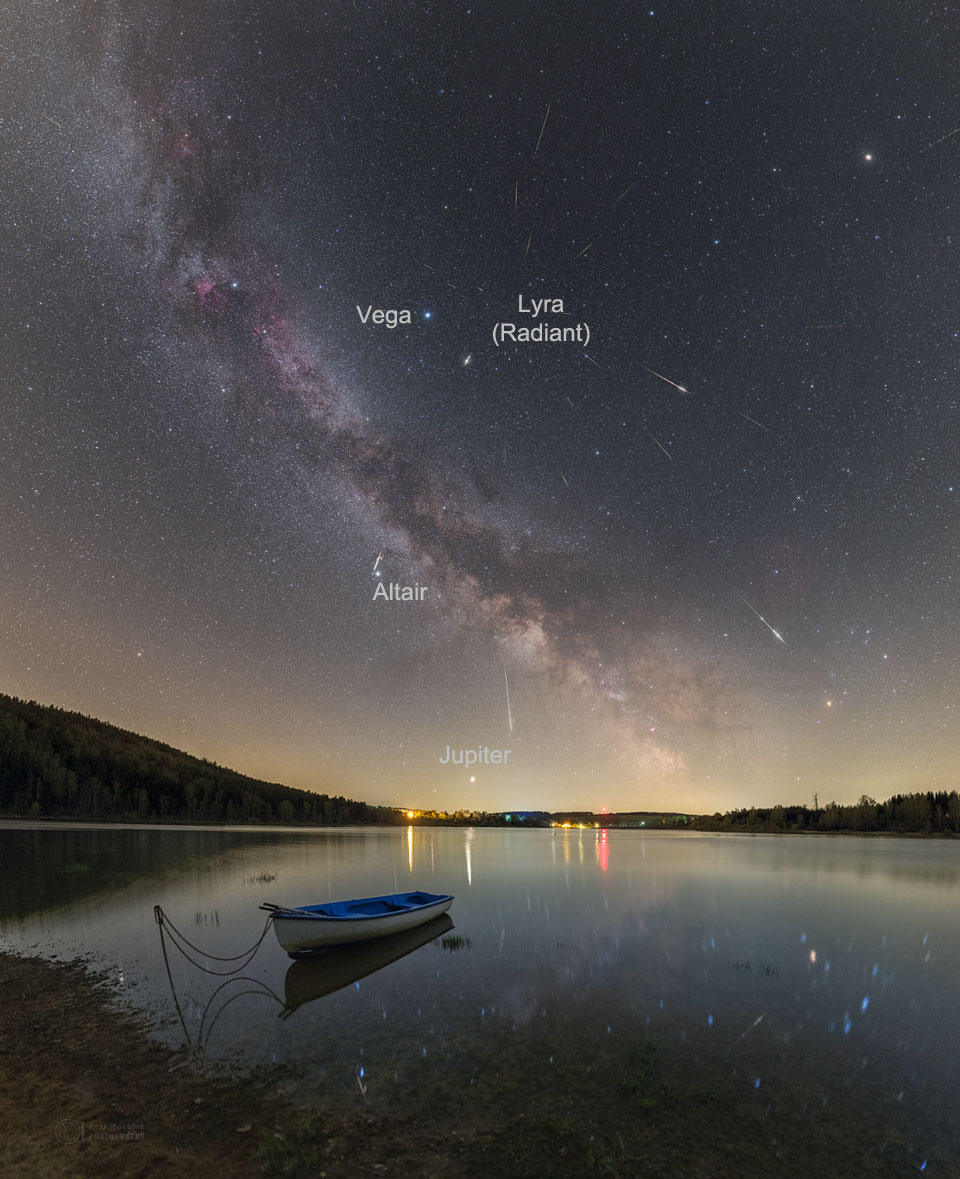
This annotated image of the Lyrids Meteor Shower was captured by Petr Horalek when the Lyrids streaked over Seč Lake in the Czech Republic in April, 2020. The meteors appear to radiate from a point in the sky in Hercules near the very bright blue star Vega of Lyra (the Harp). Don’t watch the radiant during a meteor shower! Meteors there will be very short. NASA APOD for May 12, 2020.
Hello, Moon and Meteor Lovers!
Here are your Astronomy Skylights for the week of April 18th, 2021 by Chris Vaughan. Feel free to pass this along to your friends and send me your comments, questions, and suggested topics. You can also follow me on Twitter as @astrogeoguy! Unless otherwise noted, all times are expressed in Eastern Time. To subscribe to these emails please click this MailChimp link.
I can bring my Digital Starlab portable inflatable planetarium to your school or other daytime or evening event, or teach a session online. Contact me through AstroGeo.ca, and we’ll tour the Universe, or the Earth’s interior, together!
The waxing moon will reduce the number of Lyrids meteors we see at the shower’s peak on Thursday morning, but I’m sharing some tips for watching them anyway. The moon will shine in the afternoon and evening sky all week long, so lets highlight some sights to see on it in your binoculars. Also in evening, Mars tops a triangle with its reddish doppelgangers Aldebaran and Betelgeuse, while bright Venus and Mercury kiss above the post-sunset horizon! And, of course, Jupiter and Saturn will be spectacular in the eastern pre-dawn. Read on for your Skylights!
The Moon
This week, the moon will continue to shine brightly in the evening sky worldwide as it waxes toward full next Monday. Head outside and enjoy views of the moon with your unaided eyes, and in binoculars (of any size) or backyard telescopes. As the moon increases its angle from the sun the terminator, the boundary line that divides the lit and dark hemispheres on the moon, migrates from lunar east to west. From one night to the next new regions will be dramatically lit by low-angled sunlight along that zone. I’ll highlight some features to take note of.
Tonight (Sunday) the moon will occupy the centre of Gemini (the Twins) in the western sky. The moon and those stars will set in the west shortly after 2 am in your local time zone. Watch for the dark round shape of Mare Crisium “the Sea of Crises” hugging the moon’s right-hand edge. Binoculars will reveal a non-uniform halo of bright rays emanating from a recently formed (geologically speaking, at least) crater named Proclus on Mare Crisium’s left border. The large, dark region below Crisium is Mare Fecunditatis, the Sea of Fertility.
On Monday night, the moon will hop sit to the left (celestial southeast) of the bright stars Castor and Pollux. The Sea of Tranquility is the large, round, dark-toned mare located in the moon’s northern hemisphere, just to the right of the terminator. Can you discern that it’s a bit bluer? Anomalously high concentrations of Titanium in Mare Tranquillitatis were one of the reasons to send Apollo 11 there.
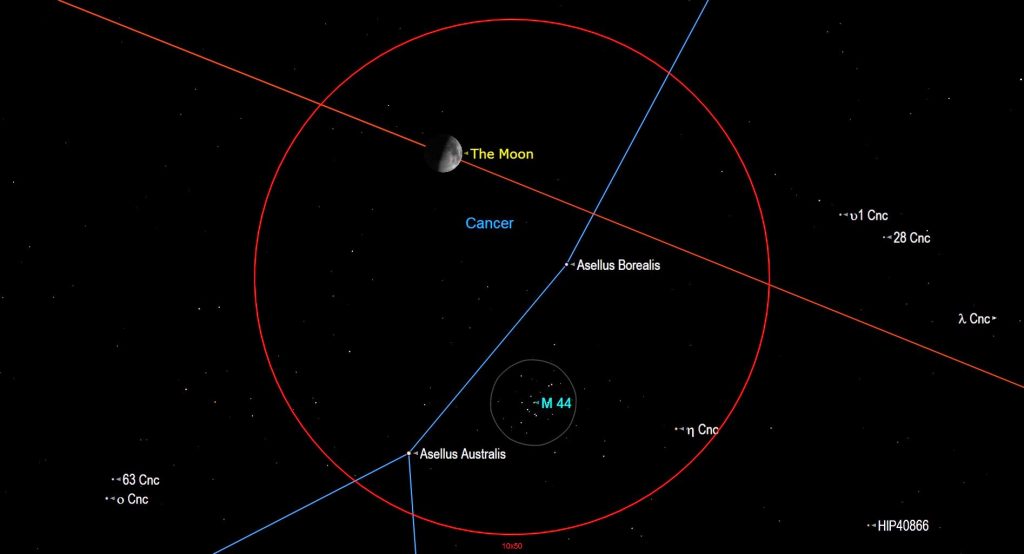
The moon will complete the first quarter of its orbit around Earth at 2:59 am EDT (or 6:59 Greenwich Mean Time) on Tuesday morning. Even though we’re used to thinking of the first quarter moon shining during the evening hours, lunar phases occur independently of the rotating Earth. While the moon is at first quarter, the relative positions of the Earth, sun, and moon will cause everyone on Earth to see the moon half-illuminated – on its eastern side.
On Tuesday night, the waxing gibbous moon will encounter a prominent open star cluster named Messier 44, Praesepe, and the Beehive, in Cancer (the Crab). In the southwestern sky after dusk, the moon will be shining several finger widths to the upper left (or 3.5 degrees to the celestial northeast) of that cluster. To better see the “bees”, hide the bright moon just beyond the upper edge of your binoculars’ field of view. Observers in western Africa and Europe, and the UK will see the moon while it is somewhat closer to Messier 44.

On Tuesday and Wednesday night the terminator will fall just to the left (or lunar west) of Rupes Recta, also known as the Lunar Straight Wall. The feature is very obvious in any sized telescope. The rupes, Latin for “cliff”, is a north-south-aligned fault scarp that extends for 110 km across the southeastern part of Mare Nubium, the Sea of Clouds. That’s the large, dark region located in the lower third of the moon’s Earth-facing hemisphere. The Straight Wall is always prominent a day or two after first quarter, and shows up again just before third quarter. For reference, the Straight Wall is located above (to the lunar north) of the bright, prominent crater Tycho. Tycho is famous for its lengthy and arrow-straight rays that extend across much of the moon’s Earth facing disk. That ray system is composed of material blasted out when Tycho was formed.
From Wednesday to Friday, the moon will journey through the constellation of Leo (the Lion). By that point, the moon will be easily spotted in the eastern sky during the afternoon. It’s safe to view the moon through binoculars or telescopes during the daytime – as long as you take extreme care not to aim your optics anywhere near the sun. Parental supervision is very important.
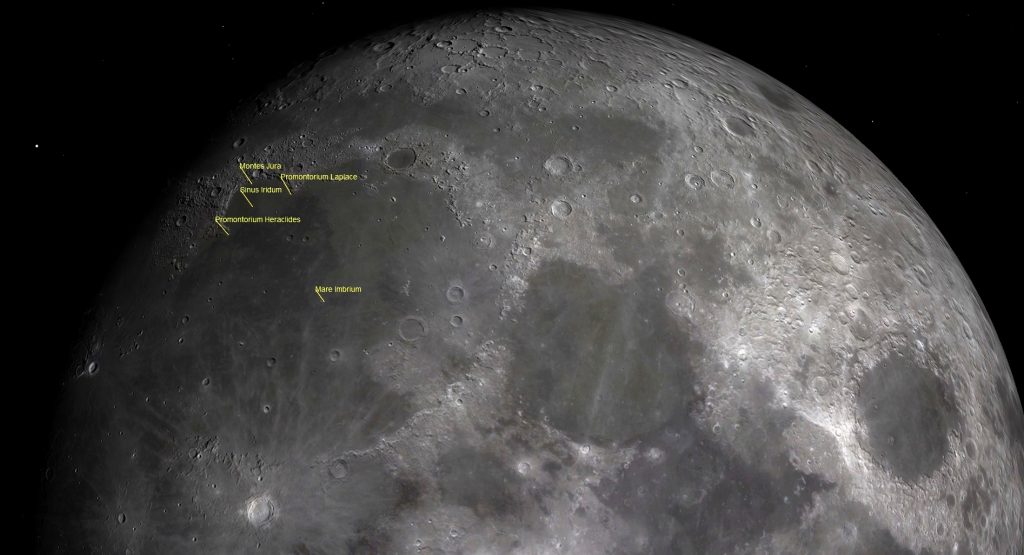
Mare Imbrium “the Sea of showers” is the huge round mare located in the north-central part of the moon. On Wednesday and Thursday, the terminator will fall to its left (lunar west). The very prominent Apennine Mountains curves along most of the right-hand (eastern) edge of Mare Imbrium. Those mountains trace out the ancient rim of the 1,150-km-wide basin that was excavated when Mare Imbrium was blasted into existence nearly 4 billion years ago.
Thursday night will bring a chance to view the Golden Handle effect. That night, the terminator will fall to the left (or lunar west) of Sinus Iridum, the Bay of Rainbows. The circular, 249-km-diameter feature is a large impact crater that was partly flooded by the same basalts that filled the much larger Mare Imbrium to its right (lunar east). The “Golden Handle” is produced when slanted sunlight brightens the eastern (right-hand) side of the prominent, curved Montes Jura, the mountain range (yes – the old crater rim) that surrounds the bay on the top and left (north and west). The mountains extend into Mare Imbrium as a pair of protruding promontories named Heraclides and Laplace at the bottom and top, respectively. You can see the feature with sharp eyes – and easily in binoculars and backyard telescopes. Sinus Iridum is almost craterless, but hosts a set of northeast-oriented dorsae or “wrinkle ridges” that are revealed under magnification at this phase.
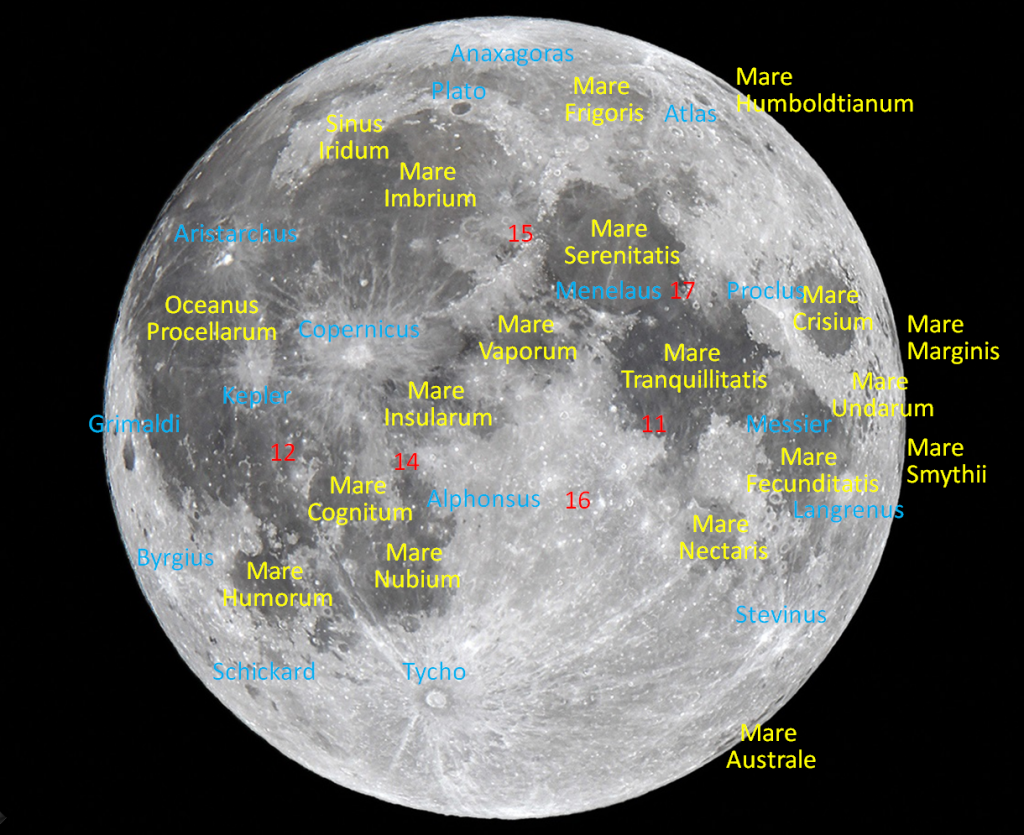
Late on Friday night, the quite bright moon will enter the large constellation of Virgo (the Maiden). It will spend the rest of the weekend traveling eastward through her. As the moon becomes nearly fully illuminated, you’ll see that its western half is mostly composed of dark region, such as the huge Oceanus Procellarum “the Ocean of Storms”. Look within the mare for the huge craters Copernicus with it halo of ragged rays, and the smaller craters Kepler and Aristarchus. On Sunday night, look for a small dark oval near the moon’s lower left (southwestern) edge. That’s Grimaldi. It’s sort of a mirror counterpart to Mare Crisium.
The Planets
After a long planet drought for sky-watchers, we’re about to get more to look at! This week, bright Venus will be gradually climbing away from the sun in the west-northwestern sky. Venus will only be visible immediately after sunset, though. Speedy Mercury is doing the same manoeuvre – and that planet will overtake slower Venus by week’s end.

Late this week, during a short period commencing at about 8 pm local time, scan just above the horizon for Venus. (You will need a horizon completely free of clouds and other obstructions.) Much fainter Mercury will be positioned about a thumb’s width to Venus’ lower right (1.5° to the celestial northwest) on Friday, a finger’s width to Venus’ right (1° north) on Saturday, and a finger’s width to Venus’ upper right on Sunday. On all three dates, the two inner planets will be close together enough to appear together in the field of view of a telescope – but the view through so much of Earth’s atmosphere will be murky at best. Ensure that the sun has completely disappeared below the horizon before searching for them. Observers living closer to the equator will see those two planets more easily. They’ll become easier for everyone to see next week.
Once the sky darkens, at around 9:15 pm local time, the tiny, reddish dot of Mars will be shining in the lower half of the western sky. A very bright yellowish star named Capella will be positioned about two fist diameters to Mars’ right (or 23° to the celestial north).
The reddish star Aldebaran in Taurus (the Bull) two fist diameters below (or 21 degrees to the celestial southwest of) Mars, and the bright star Betelgeuse in Orion (the Hunter) located just less than two fist diameters to Mars’ lower left (or 18 degrees to the celestial south), will form a large triangle in the western sky. As Mars moves east along its orbit, the stars will descend sunward faster than the planet, causing that triangle to narrow over time. Despite Mars being much farther from Earth now, your telescope will still show its small, ruddy disk. Look early – Mars will set in the west at about 1 am local time.

Saturn and Jupiter are continuing to shine in the southeastern pre-dawn sky while they travel slowly eastwards near the dim stars of Capricornus (the Sea-Goat). At the same time, the westward migration of the entire sky due to Earth’s motion around the sun is causing everything to rise a few minutes earlier every morning.
This week yellowish, medium-bright Saturn will rise in a dark sky at about 3:30 am local time. Much whiter and brighter Jupiter will join the ringed planet about 40 minutes later – about 1.5 fist diameters to Saturn’s lower left (or 14° to the east). Their separation is slowly widening because Jupiter orbits closer to the sun than Saturn, and travels eastward faster than Saturn.
Due to the very shallow angle of the morning ecliptic in springtime, Jupiter doesn’t get very high above the horizon before the dawn sky brightens, especially in mid-Northern latitudes. That makes it hard to obtain sharp views of the planet in a telescope. Since the ecliptic is more vertical for observers at southerly latitudes, both planets will be higher and clearer in telescopes there. If you are willing to get up early and take your backyard telescope outside, the Great Red Spot (or GRS) will be visible crossing Jupiter on Tuesday, Friday, and next Sunday morning. Tuesday’s GRS will be accompanied by the small black shadow of Jupiter’s moon Europa between 4:45 am EDT and dawn.

Lyrids Meteor Shower
The annual Lyrids Meteor Shower will peak before dawn on Thursday morning, April 22. This year, the moon will be in the sky for most of the night during the peak night, leaving skies less than ideal for meteor-watching. But once it sets after 4 am local time, more Lyrids should appear.
Meteor showers are events that re-occur annually when the Earth passes through zones of debris shed by the repeating passages of periodic comets with orbits that intersect Earth’s. (An analogy would be the material tossed out of a dump truck as it rattles along. The roadway gets pretty dirty if the truck drives the same route a number of times!) Over centuries, or longer, the dust-sized and sand-sized particles accumulate and spread out into a cloud surrounding the comet’s orbit. The particles are more densely distributed in the core of the cloud.
When the Earth plows through one of those clouds of cometary debris, particles are attracted by our gravity and zip through our atmosphere at speeds on the order of 200,000 km/hr. The grains moving that fast through the air generate intense heat that ionizes the air in a long, narrow tunnel surrounding the particle – producing the long glowing trails we see.
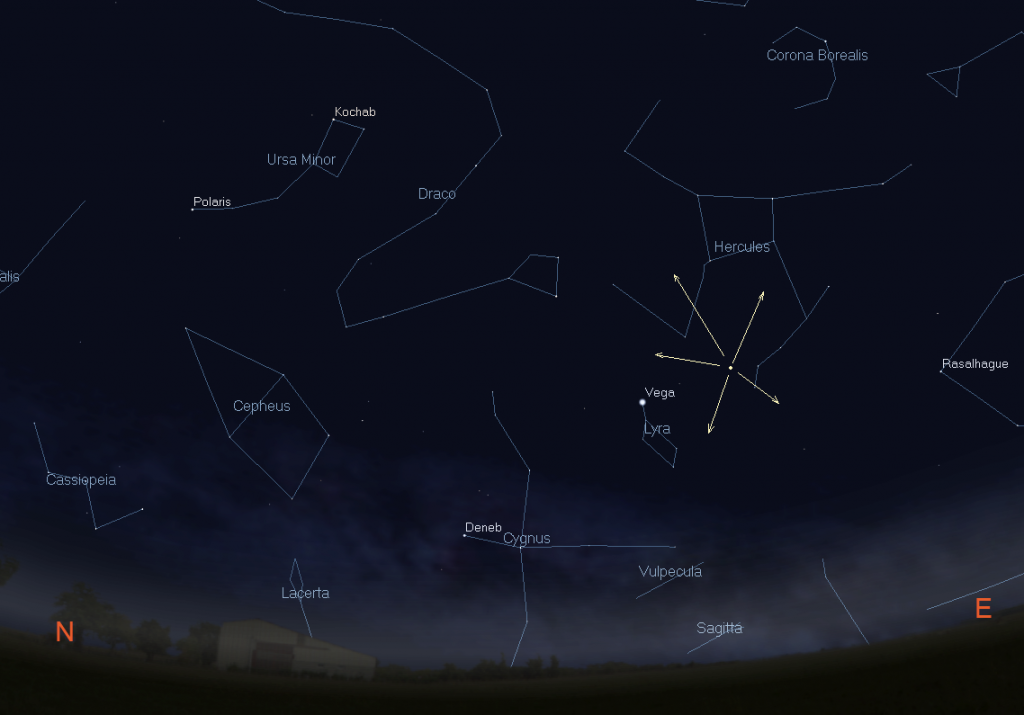
The duration of a particular meteor shower depends on the width of the debris cloud and whether the Earth moves across it perpendicularly, or performs a longer, oblique crossing. The shower’s intensity depends on whether we pass through the densest region, or merely skirt its edges. Since the Earth passes through the same part of the solar system on the same date every year, meteor showers repeat annually. Fluctuations in the geometry of the encounter cause showers to vary from their predicted behavior – and even produce unexpected outbursts in some years.
The source particles for the Lyrids shower is thought to be 416-year-period comet named C/1861 G1 (Thatcher), after its discoverer A. E. Thatcher. The active period for this shower is April 16 through April 25 every year. The Lyrids shower is known for producing up to 10-18 meteors per hour at the peak – some manifesting as bright, sputtering fireballs!
Meteor showers are best observed in the dark skies before dawn, because that’s the time when the sky overhead is plowing directly into the oncoming debris field, like bugs splattering on a moving car’s windshield. The direction in the sky that is Earth is travelling towards (or the road ahead, to use my car analogy) is called the radiant. All the meteors from a particular shower’s source will seem to be travelling away from, or radiating, from that location.
Long ago, the Lyrids radiant was located in the constellation of Lyra (the Harp), near the bright star Vega – giving this shower its name. In modern times, however, the radiant has migrated into next-door Hercules. Due to Earth’s rotation, the radiant climbs the eastern sky during evening in late April – and is nearly overhead by dawn.
The highest Lyrids meteor rates this year are expected to occur on from Wednesday night into Thursday morning April 21-22, when the Earth will be closest to the orbit of comet Thatcher and the densest part of its debris field. If you begin to watch after dark on Wednesday evening, you might catch very long meteors that are skimming the Earth’s upper atmosphere. These are fewer, but spectacular. As the night rolls on, the radiant of the meteors will rise higher in the sky, revealing more meteors because they are no longer hidden by the bulk of the Earth. The absolute best time to watch is between 4 and 5 am in your local time zone, when the radiant will be almost overhead.
For best results, try to find a safe viewing location with as much open sky as possible. You can start watching as soon as it is dark. Don’t bother to watching the radiant. Meteors near it will be heading directly towards you and will have very short trails. But do try tracing the meteors backwards to their source.
Bring a blanket for warmth and a chaise to avoid neck strain, plus snacks and drinks. Try to continuously watch the sky, even when chatting with friends or family – they’ll understand. Call out when you see one; a bit of friendly competition is fun! You’ll also see plenty of satellites gliding silently and smoothly across the sky. (Airplanes have lights that flash while satellites emit a steady (or sometimes slowly pulsing) glint of reflected sunlight.)
Keep your phone or tablet tucked away – its bright screen will spoil your dark adaptation. Alternatively, if you are able to, minimize the brightness or cover the screen with red film. Disabling app notifications will reduce the chances of unexpected bright light, too. And remember that binoculars and telescopes will not help you see meteors because they have fields of view that are too narrow. Good luck!
By the way, the nickname for meteors is “shooting stars” or “falling stars”. But meteors bear no physical connection to the distant stars at all. All of your favourite constellations will look the same as ever at the end of the shower!
Public Astro-Themed Events
Every Monday evening, York University’s Allan I. Carswell Observatory runs an online star party – broadcasting views from four telescopes/cameras, answering viewer questions, and taking requests! Details are here. Their in-person Wednesday night viewing has been converted to online via the observatory YouTube channel, where they offer free online viewing through their rooftop telescopes, including their 1-metre telescope! Details are here.
On Wednesday evening, April 21 at 7:30 pm EDT, the RASC Toronto Centre will live stream their monthly Speakers Night meeting. This month will feature star Trek: Voyager actor, musician, and amateur astronomer Tim Russ! Everyone is invited to watch the presentation live on the RASC Toronto Centre YouTube channel. Details are here. The RASC Toronto Centre has an archive of their past meetings and guest lectures on their YouTube Channel here.
On Thursday, April 22 at 12 pm EDT, RASC National will continue their weekly, half-hour moon-observing series the Moon at Noon featuring Jenna Hinds and guests. Details are here and the registration link is here! Sessions are also livestreamed to YouTube here and can be watched at any time.
On Friday night, April 23 at 7:30 pm EDT, the RASC Mississauga Centre will stream a free presentation called Skylab: An Overview. The presenter will be Emily Carney, a spaceflight enthusiast and author hailing from Saint Petersburg, Florida. More details are here.
Our in-person David Dunlap Observatory Saturday night events may be suspended at the moment, but we’re still pleased to offer alternatives – online programs! On Saturday, April 24 at 8:30 to 10 pm EDT, tune in to DDO Up in the Sky – featuring live and pre-recorded views of the night sky’s best objects captured through the telescopes of RASC Toronto Centre members. They’ll provide commentary, too. More information and the registration link can be found here. A modest fee goes to support our ongoing efforts to deliver public programs at DDO.
My free, family-friendly Insider’s Guide to the Galaxy webcasts with Jenna Hinds of RASC National returns on Tuesday afternoon, April 27 at 3:30 pm EDT. We’re going to talk about seeing satellites, including the International Space Station. You can find more details, and the schedule of future sessions, here and here.
Space Station Flyovers
There are no visible ISS (or International Space Station) passes over the GTA this week. It will return with good pre-dawn passes after April 25.
Keep looking up, and enjoy the sky when you do. I love questions and requests. Send me some!